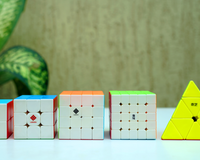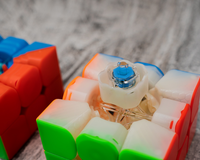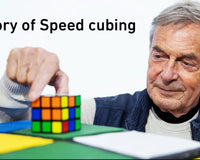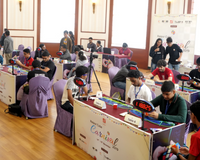If you follow speedcubing at all, I am sure you must have been amazed by high-level 2x2 solving. The ability to find the full solution in the inspection. The incredible fluid and fast turning. The insane number of algorithms. Even though it all may seem daunting, you can do all of this too!
This blog contains a complete guide for you to get to the level of solving you wish.
Before I begin I would like to tell you about my experience with 2x2. I average 1.6 seconds. I use LBL, Ortega, CLL, EG-1, EG-2, and some algorithms of LEG-1 and TCLL. I have an official 1.61 average and 0.67 single, which ranks me 4th and 2nd respectively in India.
You can learn all the algorithms I have mentioned from this sheet: https://bit.ly/3dyaEhf
The algorithms have been compiled by the best 2x2 solvers in the world.
Hardware:
First off, you need a good cube in order to improve. I will be going over the hardware and listing some cubes you can buy.
I would recommend the YJ MGC 2x2 for beginners. I personally used this cube to improve by a huge margin, going from averaging 3 seconds to 1.9 seconds.
For more advanced solvers, I would suggest going for the Moyu Weipo WR M.
These are just my recommendations. You should also try and meet people at competitions and try out their cubes, and decide what fits you best.
Beginner
So let’s say you have just started out with solving 2x2. You must be using the layer-by-layer method, which is quite simple in itself.
You should learn all 6 OLL cases and the 2 PLL cases for the method. They are very easy and translate directly from 3x3 algorithms.
Using layer-by-layer, you can easily get to 4-6 seconds provided you practice frequently.
Intermediate
At this point, you should learn the Ortega method.
Ortega involves solving a face, orienting the opposite face, then finishing with 1 of 9 algorithms called PBL. Make sure you learn algorithms for the same cases from as many angles as possible.
Judge what method fits best for each scramble you get (a mostly solved layer - use CLL. A more scrambled up cube - use Ortega)
Implementing the 2 methods together can get you to average 3 seconds, and even down to less than 3 seconds if you push it.
Advanced
After getting comfortable with LBL and Ortega, you should definitely learn CLL if you are serious about being faster at 2x2.
In CLL, you build a layer and finish off with 1 out of 42 algorithms.
It all depends on your learning pace but since this is a slightly large set, you should ideally go slow and learn one set every few days. It will take you some time (about a week) to get adjusted and be able to recall each algorithm. Just keep solving with only CLL and you will get better.
You should be able to get to 2.1 to 2.5 seconds using only CLL without one-looking.
After this point, you enter the challenging part of 2x2 improvement.
You should start off with learning EG-1 along with practicing one-looking basic layers for CLL.
To practice, one-looking, start off with a built layer and break it using R U R’. Now to solve the layer, the moves required are R U’ R’. There are 4 last layer pieces on the cube. You should visualize and track where each of the last layer pieces will end up after you do R U’ R’. Once you create the mental image of the pieces, you can predict the last layer case. Continue doing this for other common triggers like R U2 R’, R’ U R, etc. Once you are comfortable with 3-movers, practice 4-movers, and so on.
Here are some resources to help with one-looking:
Once you know EG-1, CLL, and how to one-look, sub-2 is only a matter of dedicated practice, and actively implementing the tips written below.
Turning
Contrary to popular belief, 2x2 is not just about spamming moves. Going by this formula, you will end up locking up your cube, messing up your solution, and getting slower times (especially in a competitive environment). A very real example of it is this moment:
0.73 + 2 single from Noida Cube Open 2022 finals
This ultimately cost me the gold medal at the competition.
After this, I learned to focus on having a more controlled, fluid turning style that is not too slow or too fast. I also made sure to try out more cubes to find one that could suit my new turning style.
Algorithms
You should work on optimizing your algorithms. If you feel the algorithm you use for a particular case is bad for you, you can pick another one of the many algorithms listed on the sheet for each case. Feel free to move on and learn the more advanced subsets such as LEG, TCLL, LS, etc. but make sure not to overwhelm yourself with algorithms.
Efficiency
A lesser talked about aspect of 2x2 is layer/face efficiency. A lot of cubers tend to do long solutions for layers and faces when there is an easier way to do the same. The way to get around this is by learning through 2x2 walkthrough solves on YouTube and asking your cubing friends how they would solve certain cases. You will often find that even cubers who are slower than you know something that you don’t.
That is all for this blog! Thank you so much for reading.
About Author
Shubham Maharana
Shubham Maharana is an all-rounding speedcuber from Mumbai. He is currently ranked 2nd for 2x2 Single and 7th for Sum of Ranks in India. He started cubing 8 years ago at the age of 9 and attended his first competition at 11. He was one of India’s Youngest Competition Organizers at the age of 14. He has won 23 WCA medals across 6 events.
Apart from Cubing, Shubham enjoys playing the piano, listening to music, and writing.






























